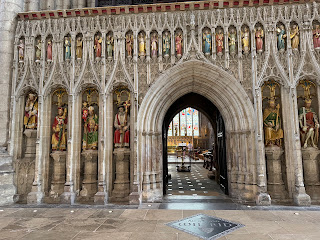Rosedale is a very pretty name and might have been even prettier when in earlier times it was connected to Europe by a land bridge and covered in dense forest. Celts and Romans left their mark as did the Saxons. In the C9th the Vikings arrived and may well have given Rosedale its name. Forget any image of a dale smothered in roses. Some believe it derives from Rossi which could be the name of a chieftain. Rossi also means horse. Then again it could come from ‘Rhos’ meaning moor, which had long since replaced virgin forest.
In ll58 a Cistercian nunnery was founded, which is remarkable in itself, for the Cistercians were essentially a male order with a profound distrust of women and, indeed they seem to have been treated by their male counterparts with little respect. They were reprimanded for financial mismanagement, urged to give less to the poor in order to avoid bankruptcy. They were told off for allowing visitors into their dormitory, and warned against allowing puppies into the church lest they disturb the service.
In 1535 the nunnery was dissolved along with other Catholic institutions as Henry and his minions went on their own distinctive property spree.
From then on, Rosedale slumbered, though the sheep remained.
Then in the 1850’s everything changed. A rich seam of high grade magnetic iron stone was discovered and the population of Rosedale rose from around five hundred to three thousand in two decades.
Now, surrounded by heather and sky, it’s hard to imagine these bleak moorlands once resounded to the clanging of hammers; the air clouded in smoke, the nights glowing in fire. Giant kilns were constructed where the iron stone was purified; track and rail lines were built built connecting the mines to the kilns, and then later to nearby Battersby from where the purified product went to the furnaces of Middlesbrough and the Tyne. At its height, 300,000 tonnes a year was being processed, Chimney Top resembling one of those early ‘gold rush towns’ in America.
A rail track bed snaking its way acrosss the moors. Ideal now for walking.
Twenty-nine years later the great ‘iron rush’ had ended, the seams now exhausted. And peace returned to the moors. Peace and rain. We'd walked two miles or so along the track, taking the occasional photo. The cloud in the picture below took offence and followed us, shedding its load as we ran back to the car - in my case less a run than an inelegant stumble. Not a pretty sight. Within moments we were drenched. How I longed to dry my jeans alongside a once fiery furnace. Instead we had pictures of clouds.



























